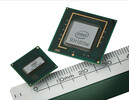Intel Graphics Media Accelerator (GMA) 900 vs Intel Graphics Media Accelerator (GMA) 500 vs Intel Graphics Media Accelerator (GMA) 950
Intel Graphics Media Accelerator (GMA) 900
► remove from comparison
The Intel Graphics Media Accelerator 900 (also known as GMA 900) is an integrated (onboard) graphic chip on the Mobile Intel 915GM chipset for Intel processors. It does not support hardware T&L (Transform & Lightning) calculations (which is required for some games).
It supports DirectX 9.0 with Shader Model 2.0 (Vertex Shader are calculated in Software - by the CPU) and OpenGL 1.4. Furthermore, the chip is able to accelerate the decoding of MPEG2 videos and supports Motion Compensation.
The GMA 900 can not be described as a graphics card that is sufficient for gamers. Still Intel published a list of games that will run (not needingly beautiful) on the notebook. Some old 3D games and especially 2D games should run without problems. The advantage of integrated graphics cards, is that they have a low power consumtion and therefore save battery life. Furthermore, the laptop may stay cooler and more silent than laptops with dedicated graphics cards. For office programs and surfing the performance is more than sufficient.
Currently there are no drivers that support Aero Glass for Windows Vista.
Intel Graphics Media Accelerator (GMA) 500
► remove from comparison
The Intel Graphics Media Accelerator 500 (also called GMA 500) is a graphics card for embedded products (e.g. MIDs), netbooks and other small mobile devices. It is usually paired with an Intel Atom CPU and designed for video playback tasks (even HD content). The integrated video decoder is able to accelerate MPEG-2, VC-1, and AVC HD videos.
The graphics core is based on a licensed PowerVR SGX core (Power VR SGX535 as in the Apple A4) and is clocked with 100 (UL11L) or 200 MHz (US15L, US15W chipset). The GMA 500 is compatible with DirectX 10.1 and features 4 unified shaders. Still the performance wont be sufficient for playing 3D games.
The chipsets that integrate the GMA 500 (UL11L, US15L, and US15W) support
| UL11L | US15L | US15W | |
|---|---|---|---|
| Core Speed | 100 | 200 | 200 MHz |
| Max RAM | 512 MB | 1024 MB | 1024 MB |
| max Displays | 1 | 2 | 2 |
| PCIe Slots | 1 | 2 | 2 |
Intel Graphics Media Accelerator (GMA) 950
► remove from comparison
The Intel Graphics Media Accelerator 950 (also known as Intel GMA 950) is an integrated (onboard) graphic chip on the Mobile Intel 945Gx chipset for Intel processors. It is a faster clocked version of the GMA 900 and does not support hardware T&L (Transform & Lightning) calculations (which is required for some games). Compared to the GMA 900 it now supports Shader Model 3.0 (instead of 2.0) and can decode 2 HD Streams simultaneously.
It supports DirectX 9.0 with Shader Model 3.0 (Vertex Shader are calculated in Software - by the CPU) and OpenGL 1.4. Furthermore, the chip is able to accelerate the decoding of MPEG2 videos and supports Motion Compensation (2 HD Streams simultaneously). Modern HD videos in MPEG 4 or VC-1 can not be decoded with the graphics card.
The GMA 950 is integrated in the following chipsets with different rendering clock rates (that affect the 3D performance):
- 945GU: 133 MHz (Lakeport for Intel A100 and A110)
- 945GSE: 166 MHz (for Atom)
- 945GMS: 166 MHz / 250 MHz (1.05V)
- 940GML 166 MHz / 200 MHz (1.05V) - Celeron M (ULV)
- 943GML: 200 MHz
- 945GM: 250 MHz (Calistoga)
- 945G, 945GC, 945GZ: 400 MHz (Lakeport)
Using the GMABooster tool, slower variants can be clocked to 400 MHz to increase the 3D performance (use at your own risk, not supported by Intel!).
The GMA 950 can not be described as a graphics card that is sufficient for gamers. Still Intel published a list of games that will run (not needingly beautiful) on the notebook (list is for the GMA 900). Some old 3D games and especially 2D games should run without problems. The advantage of integrated graphics cards, is that they have a low power consumtion and therefore save battery life. Furthermore, the laptop may stay cooler and more silent than laptops with dedicated graphics cards. For office programs and surfing the performance is more than sufficient.
The newest drivers support Windows Vista with Aero Glass effects and according to some of our readers it should run fluently.
| Intel Graphics Media Accelerator (GMA) 900 | Intel Graphics Media Accelerator (GMA) 500 | Intel Graphics Media Accelerator (GMA) 950 | |||||||||||||||||||||||||||||||||||||||||||||||||||||||||||||||||||||||||
| GMA Series |
|
|
| ||||||||||||||||||||||||||||||||||||||||||||||||||||||||||||||||||||||||
| Codename | GMA 900 | GMA 500 | GMA 950 | ||||||||||||||||||||||||||||||||||||||||||||||||||||||||||||||||||||||||
| Architecture | Gen. 3 | PowerVR SGX5 | Gen. 3 | ||||||||||||||||||||||||||||||||||||||||||||||||||||||||||||||||||||||||
| Pipelines | 4 / 0 Pixel- / Vertexshader | 4 - unified | 4 / 0 Pixel- / Vertexshader | ||||||||||||||||||||||||||||||||||||||||||||||||||||||||||||||||||||||||
| Core Speed | 400 MHz | 200 MHz | 250 MHz | ||||||||||||||||||||||||||||||||||||||||||||||||||||||||||||||||||||||||
| Shared Memory | no | yes | no | ||||||||||||||||||||||||||||||||||||||||||||||||||||||||||||||||||||||||
| API | DirectX 9c, Shader 2.0 | DirectX 10.1, Shader 4.1 | DirectX 9c, Shader 2.0 | ||||||||||||||||||||||||||||||||||||||||||||||||||||||||||||||||||||||||
| technology | 130 nm | 130 nm | 130 nm | ||||||||||||||||||||||||||||||||||||||||||||||||||||||||||||||||||||||||
| Features | No Hardware Transform and Lightning Support (T&L), MPEG2 acceleration, Motion Compensation | OpenGL 2.0, PowerVR SGX Kern, Screen Tiling, Internal True Color Processing, Zero overhead AA, 32 Bit floating-point operations. | No Hardware Transform & Lightning (T&L), Hardware Motion Compensation, Hardware MPEG2 acceleration | ||||||||||||||||||||||||||||||||||||||||||||||||||||||||||||||||||||||||
| Date of Announcement | 01.03.2005 | 01.11.2008 | 01.03.2005 | ||||||||||||||||||||||||||||||||||||||||||||||||||||||||||||||||||||||||
| Link to Manufacturer Page | www.intel.com | download.intel.com | www.intel.com | ||||||||||||||||||||||||||||||||||||||||||||||||||||||||||||||||||||||||
| Power Consumption | 7 Watt | ||||||||||||||||||||||||||||||||||||||||||||||||||||||||||||||||||||||||||
| Information | Windows Vista Premium Ready |


 Deutsch
Deutsch English
English Español
Español Français
Français Italiano
Italiano Nederlands
Nederlands Polski
Polski Português
Português Русский
Русский Türkçe
Türkçe Svenska
Svenska Chinese
Chinese Magyar
Magyar





